El Dorado
The Legend
The Muisca Raft
By Robert Drynan
Discovered by peasants in 1856, it is the center piece of the Gold Museum in Bogotá, Colombia. The raft is a single unit made from a lost art using a clay mold. It portrays the rite of propitiation of the God of Lake Guatavita, located north of modern-day Bogotá, and the initiation of the priest-king of the Muisca people. Gold to the Muisca was not a symbol of material wealth, but bore a powerful religious significance; the recipient of the sun’s energy, a life-giving star, and the source of fertility. When Spanish invaders got wind of the ceremony, it gave rise to the distorted legend of El Dorado. European greed led eventually to enslavement of the Amerindian people and terrible acts of cruelty. European diseases wiped out millions who had no natural immunity to them. Pursuit of the wealth of El Dorado drove exploration of the South American Continent to permanent European settlement.
* * *
The aurora of the rising sun outlined the high tree clad ridges surrounding the banks of the Laguna Guatavita, casting a green-golden patina on its smooth surface, a result of the morning light and algae. The population of the Muisca pueblo, clad in cotton finery, adorned with brilliant plumes of feathers and many wearing golden crowns, plaques and armlets, gathered at the edge of the lake. Near-by priests entered the cave where the about-to-be-anointed king-priest had been fasting, isolated from light and human contact since the death of his predecessor. They led him to the edge of the water where they removed all of his clothing and initiated the ritual of smearing his body with a viscous clay mud. When he was completely covered, but for his face, gold dust was sprinkled over him until he sparkled and glowed as the golden orb of the sun surged into the morning sky.
* * * * *
The golden one, soon to be anointed as the new Zipa was led to a balsa, a raft made of rushes, moored to the shore. On the raft four braziers began to spew smoke of burning moque, incense, drifting a fragrant cloud across the lake. The people began singing and dancing to the music of pipes and flutes. Additional braziers were lit along the shore. The golden one was led onto the balsa and heaps of golden ornaments and emeralds were placed at his feet.
He was joined by four sub-chiefs, also stripped to the skin, but decked in plumes, golden crowns, bracelets, pendants and ear-rings. Rowers boarded the balsa and it set out for the center of the lake. When the balsa arrived, a flag signaled the end of the singing and dancing. As silence fell, the anointed one cast all of his golden treasure into the depths of the lake, and then he leapt into its waters. The accompanying chiefs threw all their adornments into the lake and waited as the golden mud dissolved from the body of the new Zipa. Once the priest-king had returned to the balsa it began its return to the shore, and the singing and dancing resumed.
Saguipa became Zipa of the Muisca in the year 1536 of the Christian calendar. His rule of the Muisca people lasted less than two years. The arms of a distant empire were reaching out to crush Saguipa, his counterpart, Aquiminzaque of Hunza, leader of the second branch of the Muisca, and their culture . . . and to enslave their people.
For more information about Lake Chapala visit: www.chapala.com
- April 2024 – Issue - March 31, 2024
- April 2024 – Articles - March 31, 2024
- April 2024 - March 31, 2024









